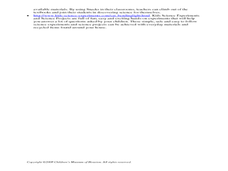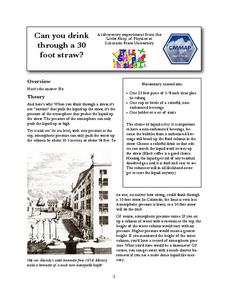Cornell University
Building a Compound Light Microscope
What better way to learn how to use a microscope than building your own? A lab investigation has scholars use lenses from magnifying glasses and sheets of cork to design their own compound microscopes. They calculate focal length and the...
Arts & Humanities
Let's Go Buggie!
To celebrate art youth month, little ones get out the magnifying glasses and get close-up with bugs. They make scientific observations of bugs you bring into the classroom. Then, they use markers, clay, paint, or crayons to make artistic...
California Academy of Science
What Would Happen?
Nothing says classroom fun like an invertebrate and a magnifying glass! Snails, earthworms, and roly-poly bugs become the center of attention as pint-sized investigators hone their inquiry and observation skills. They are guided through...
Curated OER
Experience Gravity Free Water
Students complete an experiment with a glass of water and cover the opening with cardboard and turn it over. In this gravity lesson plan, students observe how air pressure does not allow the cardboard to fall and let the water out.
Curated OER
Ruler and Magnifying Fun
First graders investigate objects using rulers and magnifying glasses. They record their observations using a data-recording sheet and write a characteristic for each item they observe. They use the ruler to solve math problems.
Curated OER
Experiencing 3D
Students explore photography by utilizing digital cameras. For this 3 dimensional lesson, students create eye glasses using red and blue acetate in order to view 3-D images. Students utilize computers and digital cameras to enhance...
Curated OER
Life Science Observations: Living vs. Non Living Things
Students investigate the difference between living and non-living things. For this life science lesson, students discover the different characteristics of living things and the natural or human created non-living things. Students...
Curated OER
Applied Science - Built Environment Lab
Students evaluate trash. In this Science lesson, students collect and weigh trash from their classrooms. Students categorize the trash and the corresponding weights, recording the information on a data sheet.
Curated OER
Identifying Elements
Students use diffraction glasses to find similarities and differences between observed spectrum of fluorescent light and an incandescent light They work in groups of 4-6 for the experiment/activity part of this exercise.
Curated OER
Seed Diversity
Students explore agriculture by researching different seeds. In this seed identification lesson, students collaborate in small groups to analyze a package of different seeds. Students utilize a magnifying glass to examine each seed...
Curated OER
The Cork Floats Where?
Have your ever noticed that a cork floats in the middle of a glass that's filled to the brim with water, but will always float along the inside edge of a glass that's only half full with water? It's true! Young scientists ponder this...
101 Questions
Nana's Lemonade
Consistency is the key. One lemon wedge per glass of water makes a nice glass of lemonade. Young scholars must identify the number of lemon wedges they need to make the same lemonade in a big gulp cup. They develop their own solution...
Curated OER
Thumbprints
Thumbprints are fascinating! Here is a clever lesson that allows kids to discover that everyone has a unique thumbprint - no two are alike! They use magnifying glasses to closely observe their own, and someone else's thumbprints. Then,...
US Department of Energy
Thermal Expansion of Water: Rise of Sea Level
Using bunsen burners, Erlenmeyer flasks, thermometers, hollow glass tubes, stoppers, and rulers, learners experiment with and measure how water expands when heated. The activity connects the expansion of water when heated to global...
Curated OER
Amazing Seeds
Three cute activities introduce youngsters to seeds and roots. In the first activity, various soaked seeds are placed in a glass so that the direction of root growth can be observed. In the second, a bag of seeds is filled with water and...
Curated OER
Greenhouse Gases
Although the worksheet for the lab activity is not included, this is an activating activity for your class to do when learning about the greenhouse effect. They lay three thermometers underneath a lamp: one out in the open, one under a...
Curated OER
Investigation of Crystallinity in Polymeric Materials
A kaleidoscope is constructed using polarizing polymer paper and then low-density polyethylene, high-density polyethylene, and polypropylene are all melted onto individual glass slides and examined through a microscope. The intent is to...
Curated OER
Light Travels Through Objects
Students experiment with materials that allow light to pass through. For this physical science lesson, students investigate the way light is absorbed by many different glass objects and household items. Students write their descriptive...
Curated OER
Extract DNA from a Banana
Your scientists-in-training extract DNA from a banana. Then, they wrap it around a glass rod in order to view the threads of DNA. They draw their observations.
Mathematics Assessment Project
Calculating Volumes of Compound Objects
After determining the volume of various drinking glasses , class members evaluate sample responses to the same task to identify errors in reasoning.
Rochester Institue of Technology
Ergonomic Design
To an engineer, the glass is never half full; it's just double the necessary size. The fifth installment of a nine-part technology and engineering series teaches pupils about the idea of ergonomic design. Measurements of popliteal height...
Big Kid Science
Create a Milk Carton Camera to Observe the Eclipse!
Step aside, fancy glasses... it's time to create a solar eclipse viewing camera of your own using nothing more than a milk carton.
Colorado State University
Can You Drink Through a 30 Foot Straw?
Drinking straws are a pretty simple device ... or, are they? Explore the possibility of sipping a beverage 30 feet away with an engaging activity that's sure to keep pupils guessing. Just place a long piece of plastic tubing in a glass,...
Radford University
Choosing the Best Cylinders
Don't be fooled: the taller glass doesn't always hold the most. Given the dimensions of different cylindrical containers for beverages and popcorn, pupils calculate the volumes. They see how changing the dimensions affects the volume and...
Other popular searches
- Magnifying Glass
- Glass Menagerie
- Glass +Craft
- The Glass Castle
- Stained Glass
- The Glass Menagerie
- Glass Mosaic
- Glass Working
- Science Magnifying Glass
- Glass Castle
- Glass Cutting
- Fused Glass

























